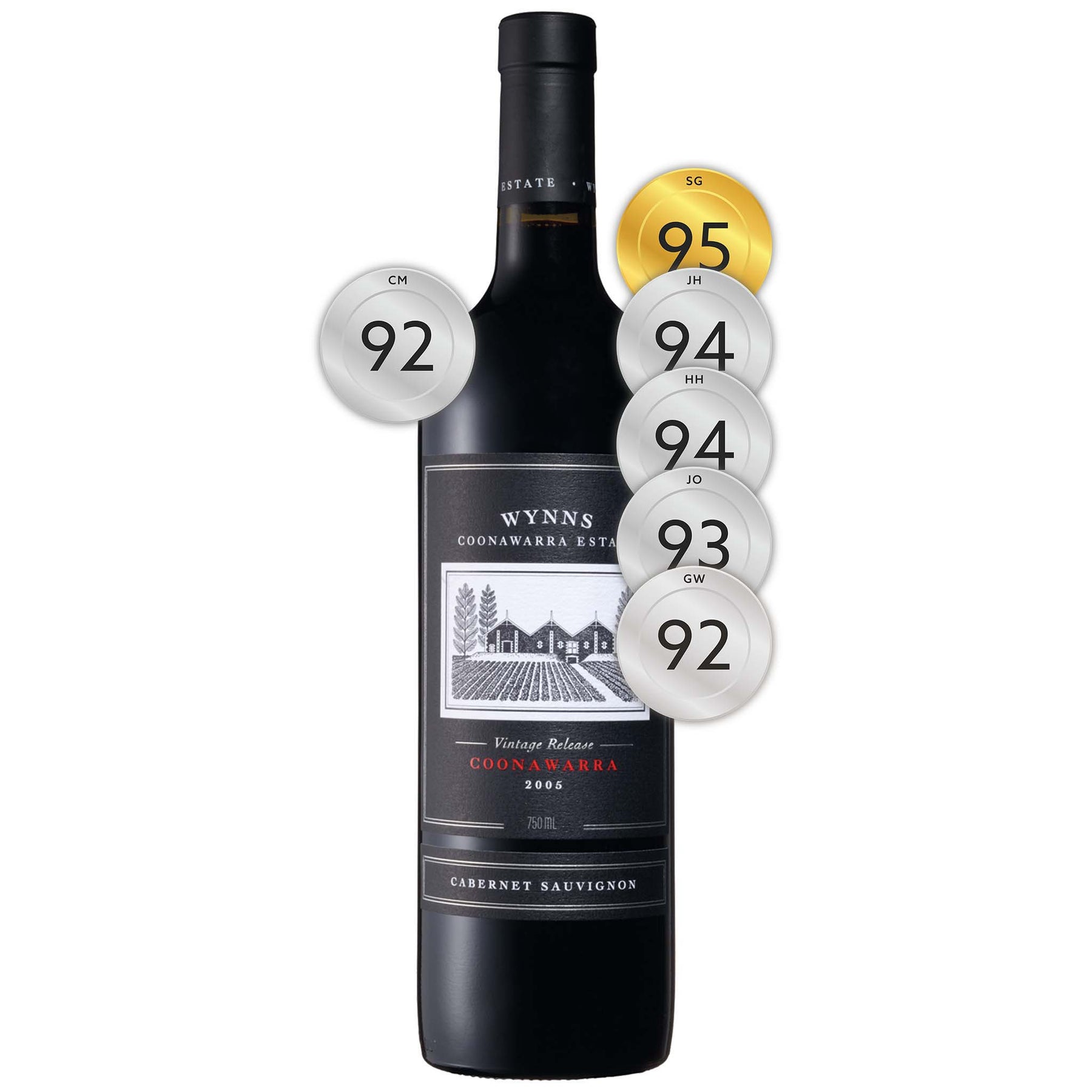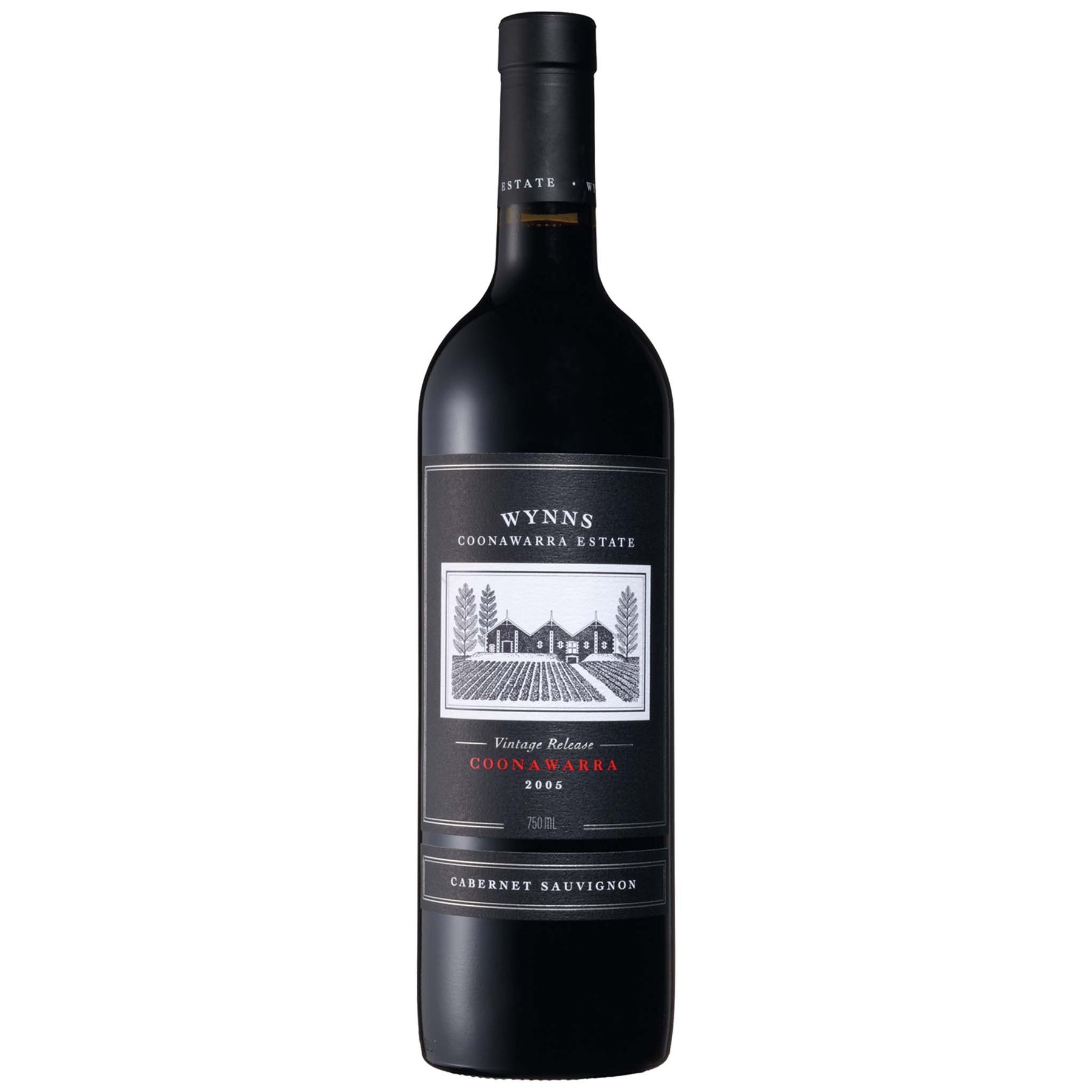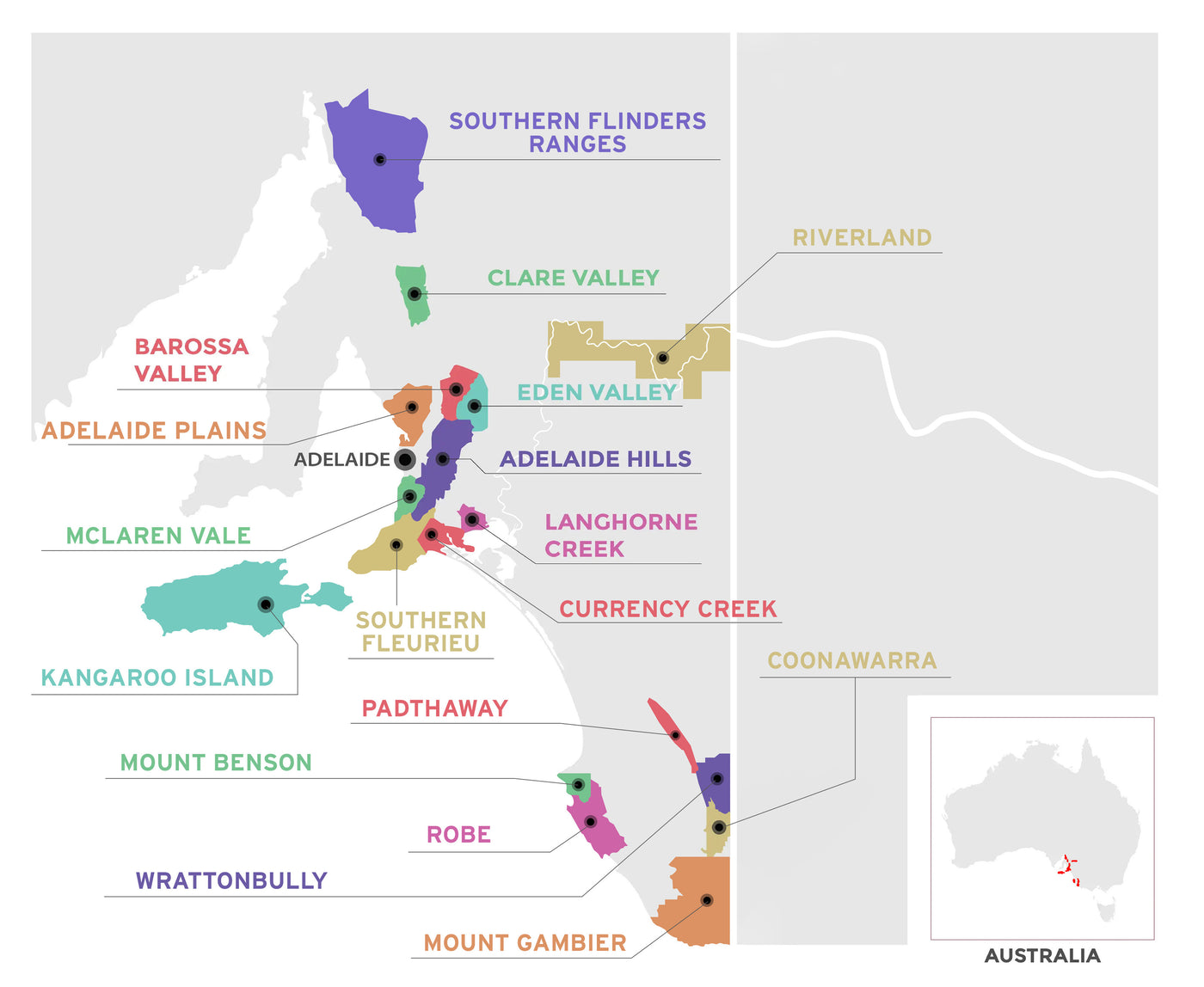

Wynns Coonawarra Estate Black Label Cabernet Sauvignon 2004
Style: Red Wine
Variety: Cabernet Sauvignon
Closure: Cork
Wynns Coonawarra Estate Black Label Cabernet Sauvignon 2004
Warehouse
34 Redland Drive
Vermont VIC 3133
Australia
Critic Score: 95
Alcohol: 13.5%
Size: 750 ml
Drink by: 2032
Wynns Coonawarra Estate Black Label Cabernet Sauvignon is a true icon of Australian wine. First produced in 1954, it was the first commercially labelled cabernet sauvignon in Australia. It has a reputation for ageing gracefully and displaying excellent varietal and regional characteristics and is one of Australia's most collected and cellared cabernets. The release of the 2015 Black Label Cabernet Sauvignon in 2017 celebrated the 60th vintage of this historic label. The quality of Wynns Black Label rests on the company's vineyard holdings in Coonawarra. 450 hectares are planted to Cabernet Sauvignon and the Black Label is drawn primarily from 240 hectares of vines over 35 years of age.
"Medium-bodied; but complex; flavours come from black fruits and licorice; from oak, but not over the top; and from tannins (ripe). The wine has considerable length and finesse, and will be long-lived." James Halliday
Expert reviews
"This was the first wine that gave the impressions of youth. A hint of blackberries and animal-skin notes. The move to more medium-bodied, elegant wines does seem to have allowed some of that dry herb character to emerge, but it is kept well in check here. Good complexity and balance. Fine tannins and, the pick of the decade so far. An exciting future." Stan Gyles, TheWineCommander - 95 points (Tasted Oct 2017)
"A more youthful colour, deep with faint purple tinges. The bouquet is fresh and bright, loaded with red fruits, the palate vibrant and fresh, clean and lively, fresh and loaded with potential. It's still youthful and promising much more. A delicious wine in a more elegant caste. Drink: 2017-2032." Huon Hooke, The Real Review - 94 points (Tasted Jul 2017)
"Medium-bodied; but complex; flavours come from black fruits and licorice; from oak, but not over the top; and from tannins (ripe). The wine has considerable length and finesse, and will be long-lived. Gold medal Sydney Wine Show '07. 13.5º alc. Drink Now - 2024." James Halliday, Halliday Wine Companion - 94 points
"An elegant and lightly herbal cool year Coonawarra cabernet whose slightly leafy expression of small black and red berries, mulberries and plums knits effortlessly with fine-grained and loose-knit tannin and smooth, creamy oak. It opens slowly to reveal a violet-like perfume, while its smooth, restrained and supple palate of vibrant fruit overlies a wonderfully tight spine and pleasing cedary undertones. Drink 2016-2024." Jeremy Oliver - 93 points
"And the overall quality in the 130 wines I tasted ($25-$40) was outstanding. Make no mistake, these are world class wines that would stack up against just about any from the great regions. In fact, you would have to spend three, four or even five times the price to get anything as good. The 2004 Wynns Coonawarra Estate Cabernet Sauvignon: The most famous name in Coonawarra and still one of the best. Sue Hodder has really worked on these wines in recent years and wines like this are just reward for the effort. Drinking beautifully now but has the structure and breeding to last for many years." Ray Jordan, West Australian – 12 Best Wines $25-$40
"Aromas of blackcurrant, slightly jubey red berry, aniseed, earth, a touch of mint and light cedar oak. Quite floral too. On the palate medium bodied with fresh red berry, blackcurrant, black olive, leather, leaf and cedar oak flavours. A light and refined cabernet with firm dry tannins and clean fresh acidity. Finishes long with red berry and tobacco flavours. Should cellar very well (of course). Drink: 2008 - 2016+." Gary Walsh, Winorama - 92 points
"I like a lot of things about this wine, but if you're looking for a big, beefy, blockbuster style - this is a long stretch away from it. It's more of an old-style, classical, Claret version of Coonawarra cabernet, with floral, violetty, pretty aromatics on a light-ish frame of blackcurrant and earth - and rather tight, though not overtly substantial, tannins. It should mature like a charm, and certainly needs a good deal more time in bottle. Drink: 2011-2016." Campbell Mattinson, The Wine Front - 92 points
"The granddaddy of Coonawarra cabernets continues to offer great regional character at a fair price. The 2004 has a restrained feel at the moment with redcurrant, plum and whispers of anise and violets on the nose. Cedary oak adds a savoury seasoning, and the palate is quite austere and traditional in style. It will improve in the bottle." Jane Faulkner, The Age 48 Hours
About the black label

Wynns Coonawarra Black Label Cabernet Sauvignon is a true icon of Australian wine. First produced in 1954, it is one of Australia's most collected and cellared cabernets. The release of the 2015 Black Label Cabernet Sauvignon in 2017 celebrated the 60th vintage of this historic label.
Wynns Black Label Cabernet has been in top form since about 2006 due primarily to the hard work put in by Chief winemaker Sue Hodder and her team. Viticulturist Alan Jenkins has worked with Sue for about 3 decades, and winemaker Sarah Pidgeon joined them 23 years ago. Sue says the Black label Cabernet is still the most important wine they make in Coonawarra, even though her team has created a number of much more expensive labels.
Over the last 20 years the team have overseen a program of revitalizing and replacing the old vines damaged by excessive machine pruning - around 25% of the vineyards have been replanted, and in some cases, vines were chainsawed down to their trunks to stimulate growth. Wynns have also purchased the best winemaking equipment available, including an optical grape sorter that had "shocking" results, according to Hodder. "The main result is brighter fruit," she says.
These improvements, together with a move to open fermentors in the winery and 100% French oak, have resulted in a more elegant and consistent style. Recent Black Label Cabernet Sauvignon vintages display precise Cabernet expression, bright lifted fruit, seamless oak integration and are elegant medium-bodied wines with great line and length and fine tannins on the finish.
The following article by Huon Hooke in The Real Review discusses the modern style of Wynns Coonawarra Black Label Cabernet Sauvignon with Chief winemaker Sue Hodder:
Chief winemaker Sue Hodder shared some insights into the modern style of Wynns Coonawarra Estate Cabernet Sauvignon 'black label' during the recent 60 vintages tasting. It's my belief that this wine is better than ever these days, or at least more consistently excellent. This is due to improvements in the vineyard and winemaking as well as better understanding of the region's natural style.
“When I came to Wynns there was not quite pressure, but an expectation that we should try to make big wines,” Sue said.
In the 1990s and early noughties, medium-bodied red wines were not as well accepted as they are today, and even in regions that naturally make medium-bodied wines, winemakers were trying to make them as full-bodied as possible. This sometimes involved adding tannin and using too much oak, as well as picking riper grapes with the corollary that acid additions were necessary.
“One thing I have learnt is to have confidence in making medium-bodied wines, which are what the region naturally produces. Earlier picking is part of that, and consequently less acid addition, but also viticultural changes have meant the vines are in better balance and are taking up less potassium, which means we have lower pHs.”
Alcohols these days are a fraction lower than in the '90s and early noughties, if not as low as the 1950s and ‘60s when the alcohols were mostly well under 13%. By contrast, the wines of the early noughties were 13.5 to 14%. Today's wines do however show typical characteristics of modern Australian reds: juicy, ripe and fresh, with lots of clean, ripe primary fruit – never overripe nor underripe.
In the cellar, a variety of fermenter types are used, and barrels are sourced from various coopers, but there has been a trend towards larger formats, with some puncheons and hogsheads as well as barriques. The move towards all French oak happened progressively during the Hodder era.
The biggest improvements have been in the vineyard, where viticultural guru Allen Jenkins has been pivotal. He says Wynns has re-planted around 25% of its vineyards in the last 10 years. When he arrived a lot of the trellises were falling down and needed renewing. Much vineyard was renovated to remove the hedge-like mass of wood that had been accumulated during the era of mechanical and minimal pruning. Vineyards were mapped in order to identify areas of low and high vigour, as this has ramifications for uneven yields and ripeness levels.
“It's also meant rejuvenating old vines and establishing new cordons, putting the correct varieties on the appropriate sites, with cabernet on the best cabernet soils, and also using the best clones and matching them with the appropriate rootstocks.”
He has re-planted with material from selected vines on Wynns' own vineyards, as well as new Entav French clones, and heritage clones such as the Reynell selection and the Houghton clone.
With a view to getting the pruning levels right (which has direct implications for crop level the following season), thousands of bud dissections are performed – between 5000 and 10,000 a year – before the pruners are sent in, and this has been going on for nearly 20 years. Bud dissection tells them what the crop-level will be in the coming year so they can prune accordingly. Hence pruning is more precise. To that end, all old vines are pruned manually, while younger vines are pre-pruned by machine and then ‘cleaned up' manually.
Harvesting the best possible fruit at the ideal moment is probably the area where the biggest strides have been made, and also where there's the greatest potential for even more improvement.
Dr Cath Kidman, a viticultural researcher (and daughter of local wine producers Sid and Susie Kidman) is working on primary bud necrosis, which is a serious problem that has only been identified in recent years. This is where the primary bud dies for no apparent reason, then the secondary bud bursts and produces a shoot, leaves and fruit, but the ripening is delayed by up to a fortnight (with 2 degrees Baumé less sugar ripeness), which means it will add green flavours to the wine if harvested at the same time as the ripe bunches.
So, if we think the current Wynns reds are good, it's likely the future will bring even better things. It's a very exciting time. Huon Hooke, The Real Review (Aug 2017)
Sue Hodder

Sue Hodder is one of Australia's best-known winemakers. Sue grew up in Alice Springs and began her wine career as a viticulturist before moving into winemaking. She joined Wynns in 1993 as a winemaker under the guidance of Peter Douglas before being appointed senior winemaker in 1998.
Sue celebrated her 30th vintage at Wynn's in May 2022 in the same year that the winery celebrated 40 years of the winery's John Riddoch Cabernet Sauvignon, named after the pioneer who first plated the vineyards back in 1891.
After 30 vintages, Hodder said: “I still have great joy in walking out the back door to our historic triple-gabled winery. While this beautiful building remains largely untouched, we do now use smaller tanks, oak fermenters, different oak barrels, and an optical berry sorter. These winemaking tools just enable us to be more confidently creative. Our winemaking team has had remarkably few changes over the years – we are a family at Wynns, and our house style remains clear.”
Sue Hodder has been the guiding light for Wynns since the nineties, supported by viticultural guru Allen Jenkins and winemaker Sarah Pidgeon. Over the last 20 years the team have overseen a program of revitalizing and replacing the old vines damaged by excessive machine pruning. Since 2002, 300 hectares of vines have been rejuvenated. They have also purchased the best winemaking equipment available, including an optical grape sorter that had "shocking" results, according to Hodder. "The main result is brighter fruit," she says.
In addition, Sue has initiated a move to open fermentors in the winery and 100% French oak, which together with the viticultural improvements, have resulted in more elegant wines with greater fruit purity and very bright, precise fruit flavours and aromas.
Sue and Allen were joint winners of the 2010 Gourmet Traveller WINE Winemaker of the Year Award, among many other accolades Sue has picked up in her esteemed career. In 2021 Sue became a Fellow of the Australian Society of Viticulture and Oenology (ASVO) for her outstanding and meritorious contribution to Australian wine
About the winery

What is now Wynns Coonawarra Estate was founded by Scottish pioneer John Riddoch. He planted vineyards in 1891 and built the famous three-gabled winery. By 1897, 89 hectares of vines had been cultivated. After a promising start, the Coonawarra Fruit Colony (as it was called then) failed to prosper due to its distance from major markets and poor economic conditions. John Riddoch died in 1901 at the age of 73.
In 1951, Melbourne wine merchants Samuel Wynn and his son David purchased Riddoch's original vineyards and winery and renamed the property Wynns Coonawarra Estate. The Wynns family recognised the intrinsic qualities of Coonawarra wines – their richness and intensity of fruit character – and set out to build an independent identity in the region. David took over the winery operations in 1953, and commissioned Melbourne artist Richard Beck to produce a woodcut of the winery facade. This illustration has appeared on every Wynns Coonawarra Estate label since, making it one of Australia's most recognised wine symbols.
Michael Shiraz (then called Hermitage) was a one-off from the 1955 vintage. The outstanding quality of the shiraz in one particular 2,300 litre vat was recognised for its quality, and bottled separately as Michael, named after David's first son. The second release of Michael Shiraz followed many years later in 1990.
Wynns increased its holdings in Coonawarra over the next two decades. By 1981, it was the largest grower in the district with 440 hectares under vine. The first wine bearing John Riddoch's name, the Wynns John Riddoch Cabernet, was produced in 1982.
David Wynn sold Wynns in the early seventies to focus on the Mountadam Venture with his son Adam. Over the last 50 years, Wynns has had many owners and in the new millennium, the company ended up in the vast portfolio of Treasury Wine Estates.
Today, Wynns Coonawarra Estate has 500 hectares of vineyards in Coonawarra and is the region's preeminent wine producer and largest single vineyard holder with the best and longest established vineyard sites in Coonawarra. Its wines are regarded as benchmarks for the district, lauded for their consistent quality, and depth of flavour.

South Australia
South Australian is responsible for more than half the production of all Australian wine. It is home to more than 900 wineries across 18 wine regions. The regions are Adelaide Hills, Adelaide Plains, Barossa Valley, Clare Valley, Coonawarra, Currency Creek, Eden Valley, Kangaroo Island, Langhorne Creek, McLaren Vale, Mount Benson, Mount Gambier, Padthaway, Riverland, Robe, Southern Fleurieu, Southern Flinders Ranges and Wrattonbully.
Many of the well-known names in the South Australian wine industry established their first vineyards in the late 1830s and early 1840s. The first vines in McLaren Vale were planted at Reynella in 1839 and Penfold's established Magill Estate on the outskirts of Adelaide in 1844.
South Australia has a vast diversity in geography and climate which allows the State to be able to produce a range of grape varieties - from cool climate Riesling in the Clare and Eden Vallies to the big, full bodied Shiraz wines of the Barossa Valley and McLaren Vale. Two of Australia's best-known wines, Penfolds Grange and Henschke Hill of Grace, are produced here. There is much to discover in South Australia for the wine lover.

